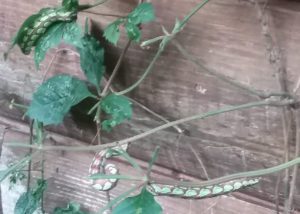Greetings BugFans,
BugFan Kine sent the BugLady some “what-is-it?” pictures of a few very hungry caterpillars on Virginia creeper, taken by her sister, Honorary BugFan Abett. The BugLady had seen an adult Abbott’s sphinx moth, but she’s never seen this wonderful caterpillar (despite the fact that she had an out-building at her old house that was being engulfed by a mass of kudzu-like wild grape). What a cool moth!

First of all, the family tree. They are in the Sphinx moth family Sphingidae, a diverse bunch of 124 species in North America (1450 worldwide) that range from the clear-winged moths now gracing wild bergamot in the prairie https://bugguide.net/node/view/1451847/bgimage, to the elegant White-lined sphinx https://bugguide.net/node/view/1477718/bgimage, to the stunning, non-native Elephant sphinx https://bugguide.net/node/view/936759/bgimage, to lunkers like the Five-spotted Hawk moth https://bugguide.net/node/view/1891122/bgimage, whose caterpillar, the Tomato hornworm, is far better known than the adult. They are stocky moths, produced by stocky caterpillars (or vice versa).
Adult Sphinx/Hawk moths feed by hovering in front of a flower (like the hummingbirds that people mistake them for) and unfurling their long proboscis to reach down into it https://bugguide.net/node/view/1045011/bgimage. Many add a behavior called “side slipping” or “swing-hovering,” in which they move from side to side while hovering; scientists think this helps them avoid predators that are lurking in the flowers. They are important pollinators.

Sphinx moth caterpillars are called hornworms because of the horn they sport at their rear https://bugguide.net/node/view/1458120/bgimage, at least in their early days. The horn is shed as the caterpillar matures (hard to tuck into a pupal case while wearing that), leaving it with a “button” on its rump in its last instar (an instar is the eating stage between molting stages). Caterpillars of many species of sphinx moths feed on toxic leaves, and they either sequester the toxins in special organs within their bodies, or they are able to excrete them quickly.
The ABBOTT’S SPHINX (Sphecodina abbottii) is found in fields, woodlands, and woodland edges from the Great Plains to the Atlantic. It has a wingspan of two to almost three inches, and its caterpillar may grow even longer. The adult’s brindle patterning allows it to blend into tree bark https://bugguide.net/node/view/1462455/bgimage, and the scales on the upturned tip of its abdomen resemble a broken twig https://bugguide.net/node/view/55214/bgimage. The BugLady usually routes people to bugguide.net for pictures, but – Wow – look at this spectacular shot http://ottawa.moths.ca/sphingidae/pages/07870-sphecodina-abbottii-A.html!
Abbott’s sphinxes are bumble bee mimics, even buzzing as they feed. Jim Sogaard, in Moths and Caterpillars of the North Woods, tells us that they get nutrients from “flowers, mud, dung, carrion, and tree sap flows.”
The caterpillar starts out green, with a small horn https://bugguide.net/node/view/422561/bgimage and then becomes icy green with an orange knob https://bugguide.net/node/view/1325390/bgimage. Later it turns either a mottled brown https://bugguide.net/node/view/954255/bgimage, which matches the woody vines of its food plants (wild grape, Virginia Creeper, and porcelainberry), or rust with green “saddles” across its back https://bugguide.net/node/view/1486385/bgimage that are said to look like a bunch of grapes. According to Sogaard, the “brown form feeds at night, resting on the woody vines during the day. The green form feeds by day and night, resting closer to the foliage.”
The horn eventually disappears, replaced by a dark knob that looks startlingly like a vertebrate’s eye https://bugguide.net/node/view/954257/bgimage, the Abbott Sphinx’s nod to the snake-head defense.

If a caterpillar is disturbed, it writhes around and tries to bite its tormentor. In his blog The Backyard Anthropology Project, Tim Eisele describes holding a caterpillar, “Handling it was a bit disturbing. Imagine picking up a raw sausage, and then having it suddenly thrash violently from side to side……” In a different blog post he says that “In addition to pretending to be a snake, it also lashed back and forth fairly violently when handled, while making kind of a “bbbrrrttt” sound by shooting air out of its breathing spiracles.”
They overwinter as pupae https://bugguide.net/node/view/958421/bgimage in underground cells. There are two generations per year in the south and only one here in God’s Country, where the adults fly in June and July.
Who was Abbott? John Abbott (1751 – 1840) (you can find it spelled with one or two “t’s”) was a London-born naturalist who came to America in 1773. He was a gifted artist who specialized in insects, illustrating them in all life stages. Along with 3,000 detailed paintings of insects https://en.wikipedia.org/wiki/John_Abbot_(entomologist)#/media/File:Abbotv1tab01AA.jpg, https://en.wikipedia.org/wiki/John_Abbot_(entomologist)#/media/File:AbbotV1Tab02A.jpg, he also drew plants and birds. According to an article in the New Georgia Encyclopedia, “Abbot’s meticulous illustrations and careful writing chronicle the habitats, life cycles, behaviors, and migratory patterns of numerous species. He also advances theories concerning the relationship between predator and prey. His work enabled others to classify closely related species, several of which were named according to Linnaean classification from Abbot’s specimens and drawings. Naturalist and evolutionary theorist Charles Darwin studied Abbot’s work prior to his own exploration of the New World.”
Kate Redmond, The BugLady
Bug of the Week archives:
http://uwm.edu/field-station/category/bug-of-the-week/
